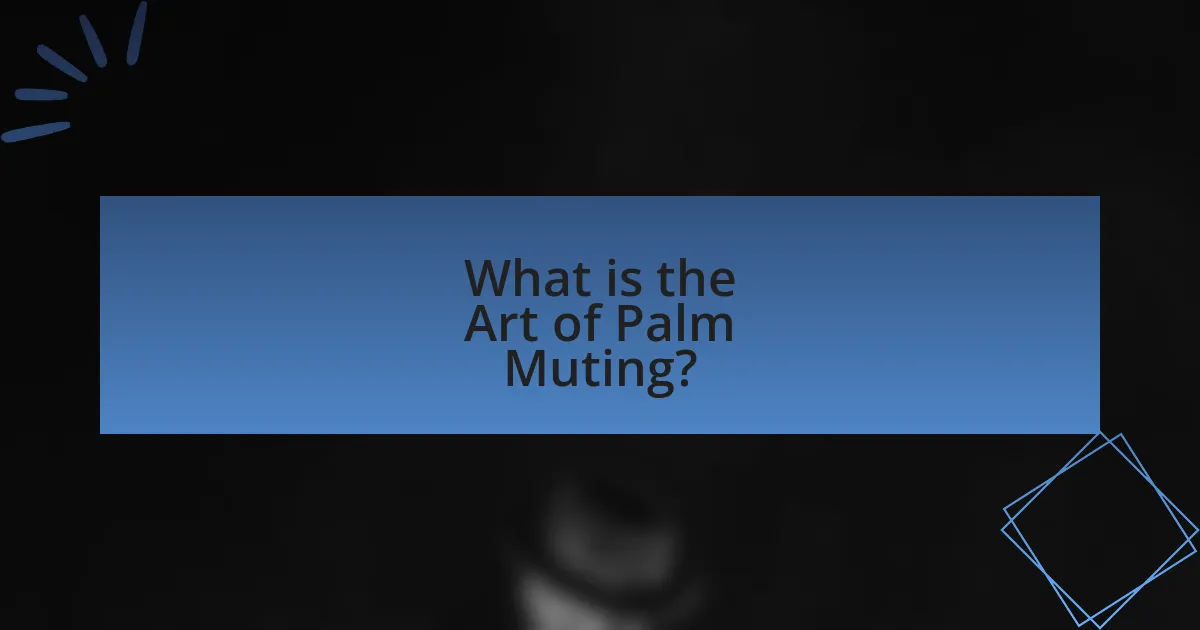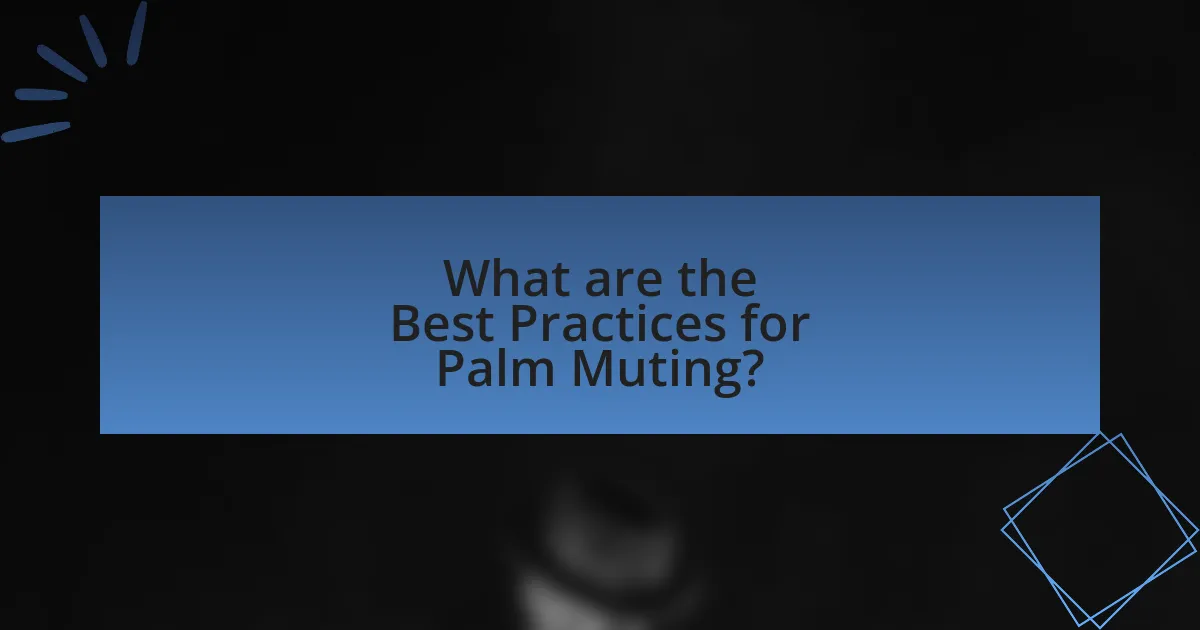The article focuses on the art of palm muting, a crucial guitar technique that enhances rock music by producing a muted, percussive sound. It explores how palm muting improves rhythm and tone, detailing its significance across various rock genres, including metal and punk. The article outlines basic and advanced techniques, offers practical exercises for beginners, and addresses common challenges guitarists face while mastering this skill. Additionally, it provides tips for optimizing tone and maintaining consistency, making it an essential resource for guitarists looking to refine their palm muting technique.

What is the Art of Palm Muting?
The art of palm muting is a guitar technique that involves resting the edge of the picking hand on the strings near the bridge while strumming or picking, which produces a muted, percussive sound. This technique is widely used in rock music to create a heavier, more aggressive tone and to emphasize rhythm. Palm muting allows guitarists to control the sustain and attack of the notes, making it a fundamental skill for achieving the desired sound in various rock genres.
How does palm muting enhance rock guitar playing?
Palm muting enhances rock guitar playing by providing a percussive, staccato sound that adds rhythmic complexity and intensity to riffs and chords. This technique allows guitarists to control the sustain and tonal quality of notes, creating a heavier, more aggressive sound that is characteristic of rock music. For example, palm muting is frequently used in genres like metal and hard rock to emphasize downstrokes and create a driving force in the music, as seen in songs by bands like Metallica and Pantera. The technique also helps to differentiate between sections of a song, allowing for dynamic contrasts that engage listeners.
What are the basic techniques involved in palm muting?
The basic techniques involved in palm muting include positioning the palm of the picking hand against the strings near the bridge of the guitar and applying varying pressure to achieve different tonal effects. This technique allows guitarists to create a muted, percussive sound that enhances rhythmic playing. By adjusting the placement of the palm and the amount of pressure applied, musicians can control the degree of muting, resulting in a range of sounds from subtle to pronounced. Palm muting is commonly used in rock music to add dynamics and texture to riffs and chords, making it an essential technique for guitarists.
How does palm muting affect tone and dynamics?
Palm muting significantly alters both tone and dynamics by dampening the strings, resulting in a muted, percussive sound that emphasizes lower frequencies. This technique reduces sustain and creates a tighter, more controlled sound, which is particularly effective in rock music. The dynamics are also affected, as palm muting allows for greater contrast between muted and open notes, enabling guitarists to create rhythmic variations and accentuate specific parts of a musical phrase. This is evidenced by the fact that many rock guitarists, such as Dimebag Darrell and Kirk Hammett, utilize palm muting to enhance their playing style, showcasing its importance in achieving a distinct sound.
Why is palm muting important for rock guitarists?
Palm muting is important for rock guitarists because it creates a percussive sound that enhances the rhythmic quality of their playing. This technique allows guitarists to control the sustain of notes, producing a tighter, more aggressive tone that is characteristic of rock music. Additionally, palm muting helps to emphasize downstrokes, which are crucial in genres like heavy metal and punk rock, where a driving rhythm is essential. The technique also contributes to the overall dynamics of a performance, allowing for variations in intensity and expression.
What role does palm muting play in different rock genres?
Palm muting serves as a crucial technique in various rock genres, enhancing rhythm and adding texture to guitar playing. In heavy metal, for instance, palm muting creates a percussive sound that complements aggressive riffs, contributing to the genre’s intensity. In punk rock, it provides a driving force in fast-paced songs, allowing for a tight, staccato feel that aligns with the genre’s energetic style. Additionally, in alternative rock, palm muting can introduce dynamics, enabling guitarists to shift between softer verses and explosive choruses, thereby enriching the overall musical landscape. This technique’s versatility across genres demonstrates its significance in shaping the sound and feel of rock music.
How can palm muting contribute to a guitarist’s style?
Palm muting significantly enhances a guitarist’s style by adding a percussive and rhythmic quality to their playing. This technique allows guitarists to create a distinct sound that emphasizes the attack of the notes while dampening the sustain, which is particularly effective in genres like rock and metal. For instance, many iconic riffs, such as those by Metallica and Pantera, utilize palm muting to achieve a heavier, more aggressive tone that defines their musical identity. This technique not only contributes to the overall texture of the music but also allows for dynamic contrast, enabling guitarists to switch between muted and open notes seamlessly, thereby enriching their performance style.

What are the Techniques of Palm Muting?
The techniques of palm muting include the following: resting the edge of the palm on the strings near the bridge while picking, adjusting the pressure to control the muting effect, and varying the position of the palm for different tonal qualities. This technique is commonly used in rock music to create a percussive sound and to emphasize rhythm. The effectiveness of palm muting is evident in various rock genres, where it enhances the overall dynamics and texture of the guitar performance.
How can beginners effectively learn palm muting?
Beginners can effectively learn palm muting by practicing the technique with consistent hand positioning and rhythm exercises. To start, place the edge of your picking hand lightly against the strings near the bridge while strumming, which creates a muted sound. Gradually incorporate this technique into simple chord progressions or riffs, focusing on maintaining a steady tempo. Research indicates that consistent practice of palm muting enhances a guitarist’s ability to control dynamics and articulation, essential for rock music.
What exercises can help develop palm muting skills?
To develop palm muting skills, guitarists can practice exercises that focus on controlling the muting technique while playing various rhythms and notes. One effective exercise is to play open strings while lightly resting the palm on the strings near the bridge, alternating between muted and open notes to create a percussive sound. Additionally, practicing power chords with palm muting can enhance control; for example, play a power chord on the fifth fret while muting the strings with the palm, then strum down and up, ensuring the muted notes are consistent. Another beneficial exercise involves playing simple riffs or scales, incorporating palm muting on specific beats to develop timing and precision. These exercises are validated by their common use among guitar instructors and musicians, emphasizing the importance of consistent practice for mastering palm muting techniques.
How can beginners avoid common mistakes in palm muting?
Beginners can avoid common mistakes in palm muting by ensuring proper hand positioning and applying consistent pressure. Correctly positioning the palm near the bridge of the guitar allows for a clearer muted sound, while applying too much or too little pressure can lead to unwanted noise or a lack of muting effect. Additionally, practicing with a metronome helps beginners develop timing and rhythm, which are crucial for effective palm muting. Studies show that consistent practice with a focus on technique leads to improved performance, as evidenced by the success of guitarists who emphasize foundational skills.
What advanced techniques exist for experienced guitarists?
Advanced techniques for experienced guitarists include hybrid picking, sweep picking, and advanced palm muting. Hybrid picking combines fingerpicking and flatpicking, allowing for greater speed and fluidity in playing. Sweep picking enables guitarists to play arpeggios rapidly by using a single motion across multiple strings, which is essential in genres like metal. Advanced palm muting techniques involve varying the pressure and position of the palm on the strings to create different tonal qualities and rhythmic effects, enhancing the overall sound in rock music. These techniques are widely used by professional guitarists to achieve complex musical expressions and are supported by instructional resources and masterclasses from renowned guitarists.
How can guitarists incorporate palm muting into solos?
Guitarists can incorporate palm muting into solos by lightly resting the edge of their picking hand on the strings near the bridge while playing. This technique creates a muted, percussive sound that adds depth and dynamics to solos. For example, using palm muting during fast runs or aggressive riffs can enhance the rhythmic feel and make the notes stand out more distinctly. Additionally, varying the pressure applied by the palm can change the tonal quality, allowing for expressive nuances within the solo.
What are the nuances of palm muting in different time signatures?
Palm muting techniques vary significantly across different time signatures, affecting the rhythmic feel and articulation of the music. In 4/4 time, palm muting often emphasizes the backbeat, creating a tight, percussive sound that complements the snare hits on beats two and four. In contrast, 3/4 time allows for a more flowing, waltz-like feel, where palm muting can soften the downbeat while accentuating the off-beats, resulting in a more dynamic expression. In 6/8 time, palm muting can enhance the triplet feel, allowing guitarists to create a rolling rhythm that supports the underlying pulse. Each time signature influences how palm muting interacts with the overall groove, making it essential for guitarists to adapt their technique accordingly to achieve the desired musical effect.

What are the Best Practices for Palm Muting?
The best practices for palm muting involve positioning the palm of the picking hand lightly against the strings near the bridge while striking the strings with a pick. This technique creates a muted, percussive sound that is essential in rock music. To achieve optimal results, guitarists should experiment with the pressure applied by the palm, as too much pressure can completely mute the notes, while too little may not produce the desired effect. Additionally, maintaining a consistent picking motion and angle enhances the clarity of the muted notes. Practicing with a metronome can help develop timing and precision, which are crucial for effective palm muting in various musical contexts.
How can guitarists maintain consistency in palm muting?
Guitarists can maintain consistency in palm muting by developing a steady hand position and applying uniform pressure with the palm. Consistent hand positioning ensures that the muting occurs at the same spot on the strings, which is crucial for achieving a uniform sound. Additionally, practicing with a metronome helps guitarists synchronize their muting technique with their playing tempo, reinforcing timing and rhythm. Studies in music performance indicate that repetitive practice of specific techniques, such as palm muting, leads to improved muscle memory and precision, which are essential for consistency.
What tips can improve palm muting accuracy?
To improve palm muting accuracy, guitarists should focus on consistent hand positioning and pressure. Maintaining a stable position of the palm near the bridge while applying just enough pressure to mute the strings without completely silencing them enhances clarity. Practicing with a metronome helps develop timing and rhythm, which are crucial for accurate palm muting. Additionally, using a lighter touch can prevent unwanted noise and improve the overall sound quality. Studies show that consistent practice with these techniques leads to measurable improvements in muting precision and sound articulation.
How can tone be optimized while using palm muting?
To optimize tone while using palm muting, guitarists should adjust their picking technique, palm placement, and amplifier settings. Properly positioning the palm closer to the bridge enhances the muting effect, resulting in a tighter sound. Additionally, using a heavier pick can produce a more pronounced attack, which complements the muted tone. Amplifier settings, such as increasing midrange frequencies and adjusting gain levels, can further enhance clarity and sustain in the muted notes. These adjustments collectively contribute to a more defined and powerful tone while palm muting, as evidenced by the techniques employed by professional guitarists in rock music.
What common challenges do guitarists face with palm muting?
Guitarists commonly face challenges with palm muting, including inconsistent muting pressure, difficulty in achieving the desired tone, and timing issues. Inconsistent muting pressure can lead to variations in sound quality, making it hard to maintain a uniform tone across different notes. Achieving the desired tone is often complicated by the guitarist’s hand positioning and the amount of palm contact with the strings, which can result in either too much or too little muting. Timing issues arise when guitarists struggle to synchronize their muting technique with the rhythm of the music, leading to a lack of precision in their playing. These challenges can hinder a guitarist’s ability to effectively use palm muting in their performances.
How can guitarists troubleshoot issues with palm muting?
Guitarists can troubleshoot issues with palm muting by adjusting their hand position and pressure on the strings. Proper palm muting requires the guitarist to rest the edge of their picking hand lightly on the strings near the bridge while maintaining enough pressure to achieve a muted sound without completely silencing the strings. If the sound is too muffled, the guitarist should experiment with moving their hand slightly away from the bridge or reducing the pressure applied. Additionally, ensuring that the guitar is properly tuned and that the strings are in good condition can also affect the clarity of the muted sound. Regular practice and listening to recordings of palm muting can help guitarists refine their technique and identify specific issues.
What adjustments can be made to improve palm muting technique?
To improve palm muting technique, guitarists should adjust the position of their picking hand and the pressure applied to the strings. Specifically, placing the edge of the palm closer to the bridge while maintaining a light touch on the strings enhances the muting effect. This positioning allows for a clearer, more defined sound while still achieving the desired muted tone. Research indicates that proper hand positioning can significantly affect sound quality, as demonstrated in studies on string instrument acoustics.
What are some practical tips for mastering palm muting?
To master palm muting, position the edge of your palm lightly against the strings near the bridge while strumming. This technique dampens the sound, creating a percussive effect essential in rock music. Start by practicing with open chords and gradually incorporate palm muting into riffs and power chords. Consistent practice with a metronome helps develop timing and control. Additionally, experimenting with different levels of pressure on the strings allows for a variety of muted sounds, enhancing your versatility.


